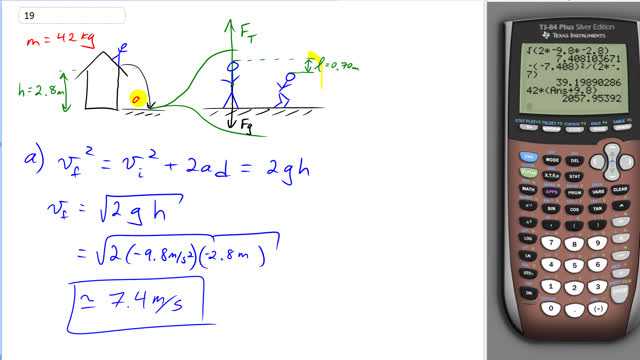
A person jumps from the roof of a house 2.8 m high. When he strikes the ground below, he bends his knees so that his torso decelerates over an approximate distance of 0.70 m. If the mass of his torso (excluding legs) is 42 kg, find
- his velocity just before his feet strike the ground, and
- the average force exerted on his torso by his legs during deceleration.

In order to watch this solution you need to have a subscription.
This is Giancoli Answers with Mr. Dychko. This 42 kilogram person jumps from the rooftop to the ground which is 2.8 meters down. And question a) asks, what will the speed be at this point? And then question b) is this zoom in part here, we're zooming in on when the person lands and they crouched just this small distance, 0.7 meters, as they bring themselves to a stop and they'll have a force on their torso up and the force of gravity down and the torso force upwards would be much larger than the gravity force down because they're accelerating up in order to come to a stop. Now, let's answer part A first. We know the initial speed when they jump off the roof is zero and we're gonna find out what the final speed is at the ground and that's plus 2ad and in this case acceleration is g and d is the height of the building. And, you know, typically height is just given as a positive number as a magnitude but I'm gonna write it in negative 2.8 meters here so that we don't have any issues with the square root here because it's a displacement downwards and so that's negative. Anyway, the final velocity then is square root of 2gh, we take the square root of both sides here. And we have square root of 2 times negative 9.8 m/s squared times negative 2.8 meters which is 7.4 m/s is how fast they'll be going when they get to the ground. And then we need to figure out what their acceleration will be given that this is their initial speed for part B. So, it's their initial speed at this time when they're standing straight up and just about to begin stopping. And then their final speed will be zero when they get to here fully crouched over a distance of 0.7 meters. And so, we can find the acceleration using this formula, final speed is zero. And then do some algebra, we'll divide both sides by... I will subtract VI squared from both sides and then divide by two times d or l, whichever you like. The legs, I guess, the amount of their legs bend. So, we have negative of negative 7.408 m/s, that's their initial speed and square that, divided by 2 times negative 0.7 meters, gives an acceleration of 39.199 m/s squared, and that's positive and it's upwards, they're accelerating up in order to come to a stop. So, the force and their torso upwards minus the force of gravity downwards is the net force, and so, it is ma. And we can add Fg to both sides to solve for the force on the torso. So, it's ma plus Fg, Fg is mg. And we can factor out the m and we have the force on the torso then is 42 kilograms times 39.199 m/s squared acceleration plus g, 9.8 m/s squared which gives with 2 significant figures 2100 Newtons.